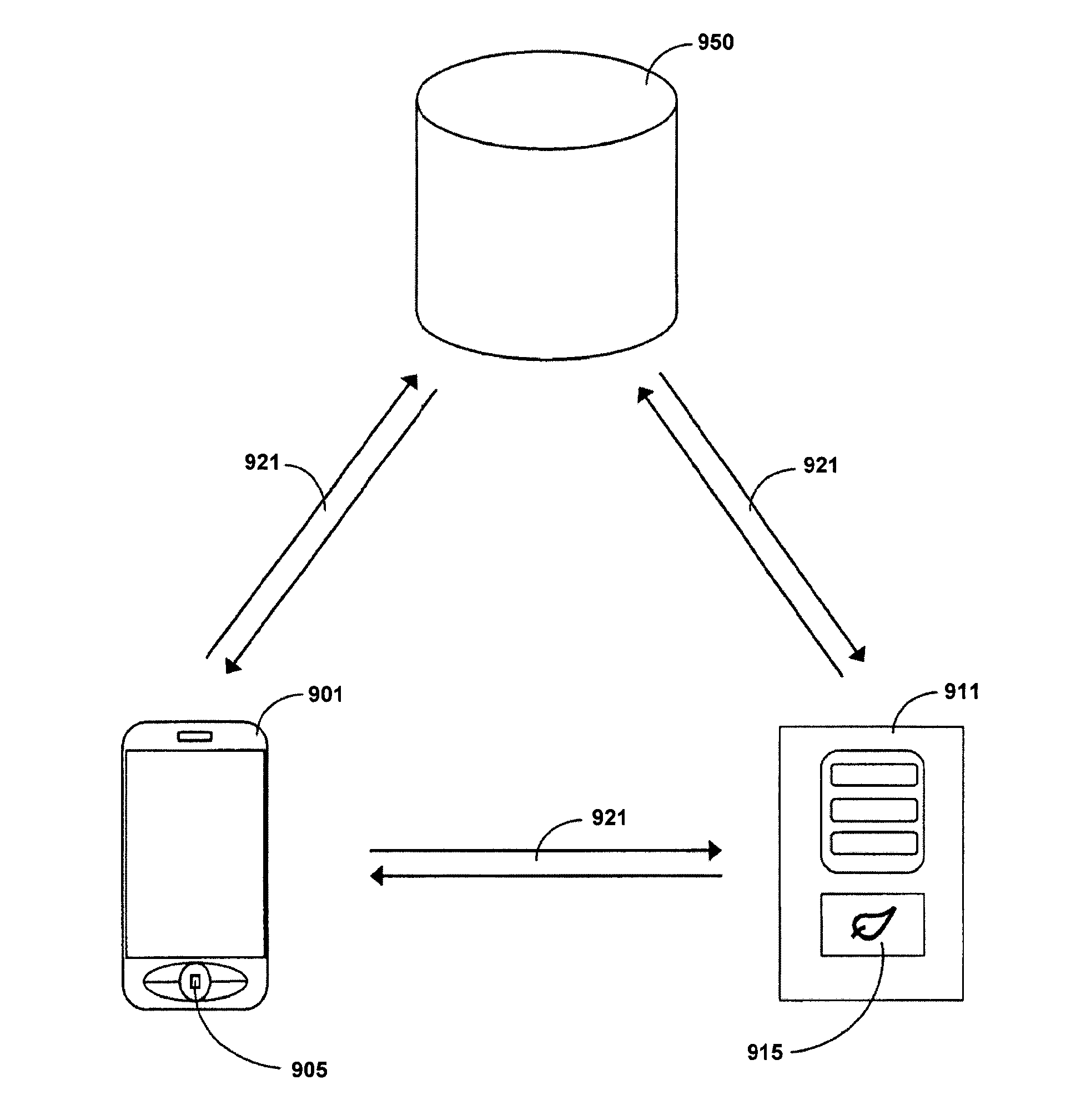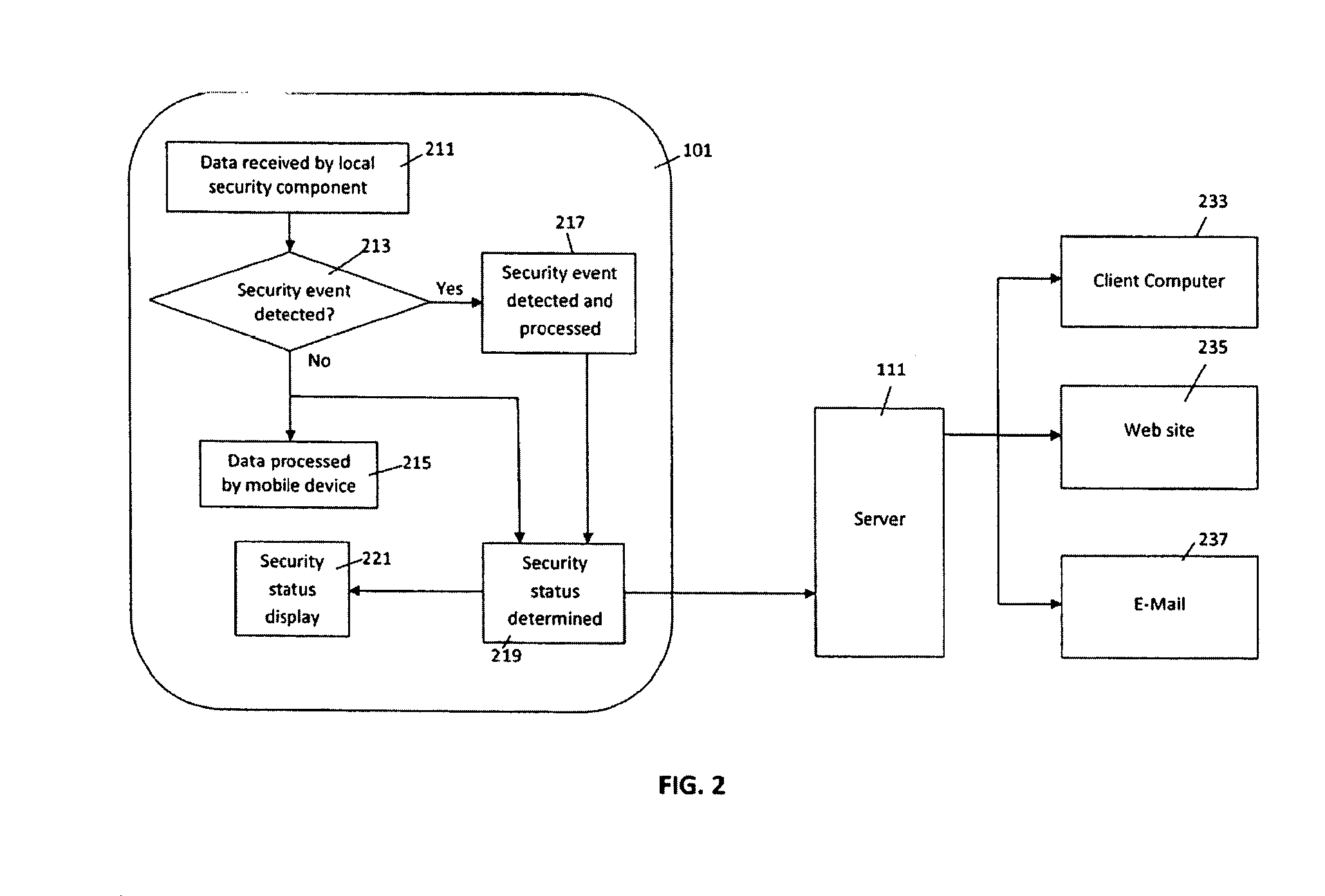Other viruses, when combined with exploits, are self-propagating worms that may not need user intervention in order to spread, potentially creating a very severe and widespread security problem.
If a device or group of devices has a security problem or has recently been attacked, the user or administrator responsible may not immediately know because mobile devices and existing solutions may not continuously present security status information and attempt to push important events to users and administrators.
Because of inherent security concerns, mobile communications devices such as mobile phones, PDAs, and smartphones have yet to provide the same breadth of trusted
connectivity found on desktop and
laptop computer platforms.
For example,
mobile device users are less likely to access confidential information and / or perform financial transactions with a mobile communications device because such devices are not sufficiently secure.
Similarly, service providers such as banks,
online payment services and providers of confidential information are less likely to offer access to their services through mobile communications devices.
As a result, mobile communications device users are limited by the types and availability of many online services.
This is because present methods for securing mobile communications devices do not contemplate many ways users may wish to access online services and online service providers, and are therefore inadequate for providing a secure platform for access to and from online services or service providers.
If the device is deficient in any way, access is denied.
Such an approach does not consider the types or levels of access required by certain service providers, nor does this approach contemplate the security and repair capabilities of the device itself.
Indeed, prior art security systems and methods ignore the recent activity of the
mobile device in relation to its overall security state.
Furthermore, prior art security systems are typically limited to authorizing access to a given network, making them unsuitable for controlling access and access levels to services and service providers based on a device's security state.
Unfortunately,
software development for mobile communications devices has not kept pace with hardware development.
Desktop cross-platform systems do not transfer well to mobile devices that lack these resources.
This presents a problem in not having a uniform API for developers to use.
Further, building such an all-inclusive
abstraction layer requires a large body of
software code, which can be difficult to manage when maintaining platform abstraction
layers for different platforms.
Because of the design of previous cross-platform systems and methods, the testing or
quality assurance (“QA”) of these systems is tedious and difficult.
Currently, there are multiple
mobile device operating systems that each cannot run software built for other operating systems.
However, it is well-known that running a
virtual machine on a mobile communications device will typically tax its resources to the point of significant performance degradation.
However, BREW is proprietary and limited to devices built upon or approved by Qualcomm®.
As such, there are significant limitations as to the type, scope and breadth of applications allowable on BREW.
Additionally, developers are restricted from accessing the low-level (
operating system) features of the mobile communications device, which limits the amount of customization and integration available.
While these early efforts provide some cross-platform functionality, they are not adequate for highly-
integrated software.
Detecting attacks on a mobile communications device presents challenges not found on traditional computing platforms.
As previously mentioned, mobile communications devices lack the hardware, software and memory resources of a traditional computer.
As such, storing vast signature databases on the mobile communications device is not feasible, and running complicated analysis systems strains the device's memory, battery, and CPU.
Other security solutions have been found unsuccessful at detecting attacks specifically directed to a mobile communications device, since mobile communications devices provide functionalities not found on traditional computers.
The lack of robust antivirus and
attack preventative measures on mobile communications devices has serious security implications.
If not protected, a significant portion of mobile devices may be vulnerable to criminal or cyber-terrorist attacks that could disrupt the
normal functioning of both commerce and government.
One skilled in the art could easily disrupt vital communications, use mobile communications devices to hack into supposedly secure servers storing confidential information, steal money via
mobile payment mechanisms, or perform a host of other malicious and nefarious acts.
However, traditional desktop,
laptop and even
server computers do not share the same
network interface issues found in modern mobile communications devices.
However, this type of
security system ignores the mobile communications device's ability to receive non-TCP / IP traffic.
However, in prior art mobile communications device security systems, only TCP / IP or other traditional network traffic is monitored and analyzed.
Not only are prior art systems unable to monitor data received over the non-TCP / IP portions of the
Bluetooth network interface, but prior art security systems lack the ability to identify, examine and track lower-level protocol
layers for any security threats.
This does not provide a complete picture of all of the data communications to and from a mobile communications device, and in particular, does not prevent attacks that do not come over TCP / IP and do not utilize the
file system before compromising the device.
For example, if a mobile communications device receives self-propagating
malware such as a worm which uses an
exploit to propagate, prior art security systems may not detect the
exploit being used to install the
malware.
Further, prior art security systems will not likely prevent the worm from spreading because outbound data transmissions, especially over non TCP / IP networks, are not often monitored.
As such, present mobile communications devices are vulnerable to a multitude of attacks, which could not only disrupt daily life, government, and commerce, but also provides a significant vehicle for large-scale cyber-terrorist or criminal attacks.
However, while there are many positive software applications available on the market, the ability to interact, install, and operate
third party software inevitably leaves the mobile communications device susceptible to vulnerabilities,
malware, and other harmful software applications.
Unlike desktop computers and other less portable computing devices that can install and run antivirus software to protect against harmful software applications, mobile communications devices lack the
processing power or resources for effectively running analogous software.
However, despite this common link, it is difficult to safeguard mobile communications devices fully at the mobile
network level, as devices may connect to additional networks and utilize encrypted services, both of which often bypass
network level protection.
One of the issues that make it difficult to protect mobile communications devices from undesirable applications is the many different types of data and applications that are available for such devices.
While service providers are able to manage the network traffic in providing applications, there is no current way to effectively monitor the behavior of these applications after they have been installed on a user's mobile communications device.
As a further result, it is difficult to identify new, previously unknown malicious applications by their behavior and to track and prevent the spread or
dissemination of damaging applications and data once they have been released to the network.
With so many different applications coming to the market, it is becoming very difficult for marketplace owners to categorize the applications, identify which applications they would like to distribute, identify which applications they would like to not distribute, and generally, keep abreast of changes.
While there are a great number of good applications, there is also a great number of bad or undesirable applications.
It can be difficult to tell which is which.
However, while there are many positive software applications available on the market, the ability to interact, install, and operate
third party software inevitably leaves the device susceptible to vulnerabilities, malware, and other harmful software applications.
Unlike desktop computers and other less portable computing devices that can install and run antivirus software to protect against harmful software applications, portable electronic devices lack the
processing power or resources for effectively running analogous software.
There exist many unscrupulous people who engage in software piracy and hacking.
Many of the application marketplaces are flooded with unauthorized application copies or versions.
The developer fails to receive compensation and may not have the resources to continue research and development on other products.
Furthermore, the definition of “peer” to any particular administrator may be fluid or difficult.
The source of an access request may be difficult to determine.
The enterprise would also not know the security status of the Wi-Fi connection or the iPhone.
MPTCP presents some problems for
security analysis and protection because security solutions that rely on observing or intercepting communications will fail when the
security solution only gets to observe or intercept some of the packets involved in a communication.
 Login to View More
Login to View More  Login to View More
Login to View More 


